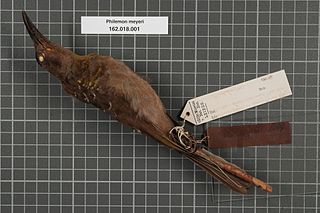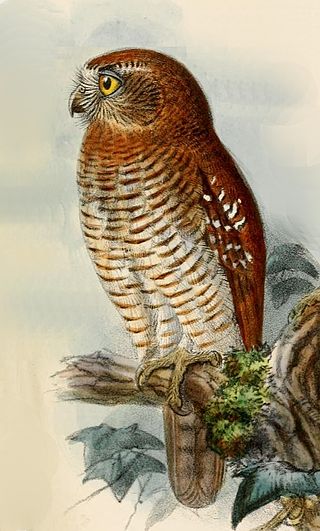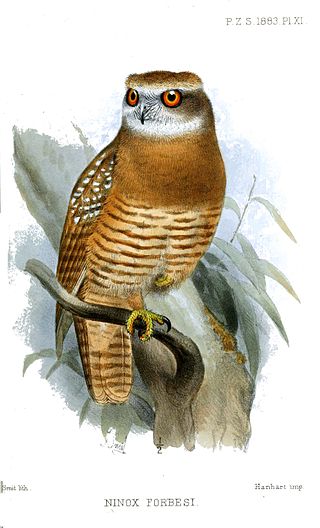
The friarbirds, also called leatherheads, are a groups of 18 relatively large honeyeaters in the genus Philemon. Additionally, the single member of the genus Melitograis is called the white-streaked friarbird. Friarbirds are found in Australia, Papua New Guinea, eastern Indonesia, and New Caledonia. They eat nectar, insects and other invertebrates, flowers, fruit, and seeds.

The Seram golden bulbul is a species of songbird in the family Pycnonotidae. It is endemic to the Moluccas. Until recently, it was considered conspecific with the northern golden bulbul and the Buru golden bulbul. Its natural habitat is subtropical or tropical moist lowland forests.

The Moluccan boobook or Moluccan hawk-owl group, are a group of owls in the family Strigidae. They are found in Indonesia. Once consider a single species, the four species are now considered part of a species complex. Natural habitat for all species is subtropical or tropical moist lowland forests.

The New Guinea bronzewing is a species of bird in the pigeon and dove family Columbidae. It is found in New Guinea. Its natural habitats are subtropical or tropical moist lowland forests and subtropical or tropical moist montane forests.

The olive-green camaroptera is a bird species in the family Cisticolidae.

The Mato Grosso antbird is a species of bird in the family Thamnophilidae. It is found in Bolivia, Brazil, and Paraguay. Its natural habitats are subtropical or tropical dry forests and subtropical or tropical moist lowland forests.

The Sulawesi blue flycatcher is a species of bird in the family Muscicapidae. It is endemic to Indonesia. Its natural habitats are subtropical or tropical moist lowland forests and subtropical or tropical moist montane forests.

The black-eared oriole, or Buru oriole, is a species of bird in the family Oriolidae. It is native to Buru island.

Meyer's friarbird is a species of bird in the family Meliphagidae. It is found throughout New Guinea. Its natural habitat is subtropical or tropical moist lowland forests.

The Buru friarbird or black-faced friarbird is a species of bird in the family Meliphagidae. It is endemic to the island of Buru in the Maluku Islands, Indonesia.

The Seram friarbird, also known as the grey-necked friarbird, Ceram friarbird, grey-necked honeyeater and gray-necked honeyeater, is a species of bird in the family Meliphagidae. It is endemic to Indonesia where it occurs on Seram Island in the Maluku Islands. Its natural habitats are subtropical or tropical moist lowland forests and subtropical or tropical mangrove forests. They are common and conspicuous and often in small groups of up to four individuals.

The Buru mountain pigeon, formerly also long-tailed mountain pigeon is a species of bird in the pigeon family Columbidae. It is endemic to Indonesia and inhabits montane forest and disturbed lowland forest on Buru. It was formerly considered to be conspecific with the Seram mountain pigeon. It is a medium-sized pigeon 33–38.5 cm (13.0–15.2 in) long, and has a blue-grey crown and neck, darker slate-grey upperparts, and a white to pale buff-pink throat and breast that becomes buff-pink towards the belly. The species is slightly sexually dimorphic, with females being smaller and having more dark red on the breast.

The Seram mountain pigeon is a species of bird in the pigeon family Columbidae that is endemic to the island of Seram in Indonesia, where it inhabits hill forest. It was long considered to be a subspecies of the Buru mountain pigeon, but was split on the basis of differences in appearance. It is a medium-sized pigeon with a buff-pink face and breast, wine-pink underparts, a grey nape, crown, back of neck, and thighs, and dark chestnut belly and underside of the tail.

The Seram boobook is a species of owl in the family Strigidae. It is found on the Indonesian islands of Seram, Kelang and Ambon. Its natural habitat is subtropical or tropical moist lowland forests. It is threatened by habitat loss. It used to be considered a subspecies of the Moluccan boobook.

The Tanimbar boobook, or Tanimbar hawk-owl, is a species of owl in the family Strigidae. It is found in the Tanimbar Islands of Indonesia. Its natural habitat is subtropical or tropical moist lowland forests. It is threatened by habitat loss. It used to be considered a subspecies of the Moluccan boobook.
The Halmahera swiftlet or Moluccan swiftlet is a species in the family Apodidae. It is endemic to North Maluku, Indonesia.

The Tanimbar oriole is a species of bird in the family Oriolidae. It is endemic to the Tanimbar Islands.
The Buru golden bulbul is a species of songbird in the bulbul family. It is endemic to Buru Island. Its natural habitat is subtropical or tropical moist lowland forests.
The Vanuatu streaked fantail is a species of bird in the family Rhipiduridae which is endemic to the Melanesian island of Vanuatu. It was formerly considered to be subspecies of the streaked fantail. Its natural habitat is subtropical or tropical moist lowland forests.

















